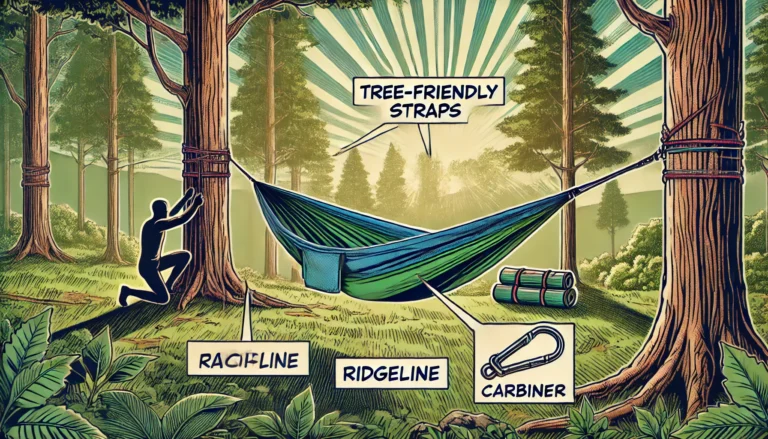Table of contents
- Introduction: How to Properly Set Up a Hammock Tent
- Choosing the Perfect Location for Your Hammock Tent
- Step-by-Step Guide to Setting Up Your Hammock Tent
- Safety Tips for Hammock Tent Camping
- Adapting Your Hammock Tent Setup for Different Weather Conditions
- Troubleshooting Common Hammock Tent Issues
- Conclusion: Mastering the Art of Hammock Tent Setup
Introduction: How to Properly Set Up a Hammock Tent
Setting up a hammock tent may seem tricky at first, but with the right instructions and a little practice, it becomes second nature. Whether you’re a solo backpacker or a weekend camper, learning how to properly set up a hammock tent is essential for a comfortable and safe experience.
Ready to elevate your camping experience? Explore the innovative features of the Haven Lay Flat Hammock Tent and gear up for your next adventure!
What This Guide Covers:
- Step-by-Step Instructions – From finding the perfect location to securing your tent.
- Pro Tips – Learn how to maximize stability and comfort.
- Safety Guidelines – Avoid common mistakes and ensure a secure setup.
- Weather Adaptations – Set up your hammock tent for any environment.
By the end of this guide, you’ll feel confident in setting up your hammock tent and ready to enjoy a peaceful night under the stars. Let’s dive in!
Choosing the Perfect Location for Your Hammock Tent
The success of your hammock tent setup starts with selecting the right location. A good site ensures both comfort and safety, making your camping experience more enjoyable.
Key Factors to Consider:
- Anchor Points:
- Look for sturdy trees or structures that are approximately 10–15 feet apart.
- Ensure the trees are healthy and capable of supporting your weight.
- Avoid using dead or damaged trees as anchor points.
- Ground Conditions:
- Choose a site with soft, clear ground to minimize risk if you fall.
- Avoid areas with sharp rocks, uneven surfaces, or thorny vegetation.
- Weather Considerations:
- Set up in areas with natural windbreaks like hills or dense vegetation.
- Avoid low-lying areas prone to flooding during rain.
- Surrounding Hazards:
- Check for overhead risks such as falling branches, also known as “widowmakers.”
- Avoid camping too close to water sources to reduce the risk of bugs and potential flooding.
- Privacy and Scenic Views:
- Opt for a spot with privacy but also consider scenic views for a more enjoyable experience.
Quick Location Checklist:
- Trees 10–15 feet apart.
- Ground is clear and soft.
- Protected from wind and rain.
- Free from overhead hazards.
- Offers privacy and a good view.
Choosing the right location is the foundation of a safe and comfortable hammock tent setup. Once you’ve found your ideal spot, it’s time to start setting up! For a detailed look at one of the most comfortable and versatile hammock tents available, check out our guide on the Haven Lay Flat Hammock Tent.
Step-by-Step Guide to Setting Up Your Hammock Tent
Now that you’ve chosen the perfect location, it’s time to set up your hammock tent. Follow these step-by-step instructions to ensure a secure and comfortable setup.
1. Attach the Straps to Anchor Points
- Wrap the tree-friendly straps around the chosen trees or anchor points.
- Ensure the straps are at a height of 5–7 feet from the ground.
- Adjust the tension so the straps are level and secure.
2. Connect the Hammock Tent
- Use the provided carabiners to attach your hammock tent to the straps.
- Adjust the position to ensure the hammock hangs at a 30-degree angle for optimal comfort.
- Ensure the hammock is centered between the anchor points.
3. Install the Ridgeline (if applicable)
- Set up the ridgeline to provide structure and support for your rainfly or bug net.
- Ensure the ridgeline is taut but not overly tight.
4. Attach the Rainfly
- Drape the rainfly over the ridgeline to protect against rain and wind.
- Secure the corners of the rainfly to the ground or nearby anchor points using guy lines.
- Adjust the tension to ensure the rainfly covers the entire hammock.
5. Add a Bug Net (if Needed)
- Install the bug net over the hammock, ensuring it fully encloses your sleeping area.
- Attach the net securely to the ridgeline or designated loops on the hammock tent.
6. Adjust the Hammock’s Height
- The hammock should hang at a height where the lowest point is 18–24 inches off the ground.
- Ensure the hammock is even and not tilted to one side.
7. Check Stability
- Before getting in, gently pull on the hammock and straps to ensure everything is secure.
- Inspect all connections, including straps, carabiners, and ridgeline.
Tips for a Successful Setup
- Practice setting up at home before your trip.
- Use a gear organizer or tarp to keep items off the ground.
- Adjust tension regularly for stability and comfort.
Safety Tips for Hammock Tent Camping
Setting up a hammock tent is only half the journey; ensuring safety is just as important. Follow these tips to make your camping experience secure and worry-free.
1. Choose Strong Anchor Points
- Tip: Always select healthy, mature trees or solid structures as anchor points.
- Why it Matters: Weak or dead trees can break under weight, posing a serious risk.
2. Use Tree-Friendly Straps
- Tip: Opt for straps at least 1 inch wide to minimize tree damage.
- Why it Matters: Narrow straps can harm the tree’s bark, impacting the environment.
3. Check Weight Limits
- Tip: Ensure your hammock tent and suspension system can support your weight plus gear.
- Why it Matters: Exceeding weight limits can cause straps or fabric to fail.
4. Maintain Proper Height
- Tip: Hang your hammock so the lowest point is no more than 18–24 inches above the ground.
- Why it Matters: A lower height minimizes injuries if you fall.
5. Inspect Your Gear Regularly
- Tip: Check all straps, carabiners, and the hammock fabric for signs of wear or damage.
- Why it Matters: Damaged gear can fail unexpectedly, especially under stress.
6. Avoid Over-Tightening Straps
- Tip: Maintain a 30-degree angle between the straps and the ground.
- Why it Matters: Over-tight straps increase pressure on the hammock and anchor points, risking breakage.
7. Keep the Area Clear
- Tip: Ensure the ground below your hammock is free of rocks, branches, or sharp objects.
- Why it Matters: A clear area reduces injury risks in case of a fall.
8. Be Weather-Wise
- Tip: Always secure your rainfly and adjust it based on weather conditions.
- Why it Matters: Rain or high winds can destabilize your setup if not properly prepared.
9. Practice Getting In and Out Safely
- Tip: Sit in the hammock first to test stability before lying down.
- Why it Matters: Sudden movements can cause tipping if the hammock isn’t balanced.
10. Follow Leave No Trace Principles
- Tip: Use tree-friendly gear and avoid damaging vegetation in your campsite.
- Why it Matters: Preserving the environment ensures future campers can enjoy it too.
Adapting Your Hammock Tent Setup for Different Weather Conditions
Weather can greatly impact your hammock tent camping experience, but with the right adjustments, you can stay comfortable in any environment. Here’s how to adapt your setup for various conditions.
1. Rainy Weather
- Key Adjustments:
- Attach a waterproof rainfly over the ridgeline, ensuring it covers the entire hammock.
- Angle the rainfly to direct water runoff away from your gear.
- Use drip lines on the straps to prevent water from seeping into the hammock.
- Pro Tip: Secure the rainfly tightly but allow enough slope for proper drainage.
2. Windy Conditions
- Key Adjustments:
- Position your hammock tent near natural windbreaks like rocks, hills, or dense vegetation.
- Ensure the rainfly is anchored securely to prevent it from flapping.
- Use additional guy lines to stabilize the setup.
- Pro Tip: Set up with the hammock’s length parallel to the wind direction for less resistance.
3. Cold Weather
- Key Adjustments:
- Use an underquilt or insulated sleeping pad to trap body heat.
- Layer with a thermal blanket or sleeping bag rated for cold temperatures.
- Seal gaps in the rainfly to reduce heat loss.
- Pro Tip: Wear moisture-wicking base layers to stay dry and warm overnight.
4. Hot and Sunny Weather
- Key Adjustments:
- Set up in a shaded area to minimize sun exposure.
- Use a lightweight, reflective rainfly to deflect heat.
- Keep the hammock’s sides open for maximum airflow.
- Pro Tip: Hang a mesh bug net to maintain airflow while keeping insects away.
5. Snowy Conditions
- Key Adjustments:
- Choose sturdy anchor points capable of handling snow weight.
- Position your hammock lower to reduce exposure to wind.
- Use snow stakes or bury guy lines in the snow for stability.
- Pro Tip: Pack snow beneath the hammock to create an insulating barrier.
6. Variable Weather
- Key Adjustments:
- Prepare for sudden weather changes with versatile gear like adjustable rainflies and multi-season sleeping bags.
- Regularly check tension and anchors to ensure stability as conditions shift.
- Pro Tip: Keep gear like tarps and extra guy lines easily accessible for quick adjustments.
Quick Weather Adaptation Checklist
- Rain: Rainfly, drip lines, angled setup.
- Wind: Natural windbreaks, extra guy lines.
- Cold: Underquilt, thermal layers, sealed rainfly.
- Heat: Shade, open sides, bug net.
- Snow: Low setup, snow stakes, insulated layers.
Troubleshooting Common Hammock Tent Issues
Even with proper setup, you may encounter some challenges while using your hammock tent. Here’s a guide to solving the most common issues so you can enjoy a hassle-free camping experience.
1. Hammock Sagging Too Low
- Problem: The hammock sinks too close to the ground after setup.
- Solution:
- Ensure the straps are tight and positioned higher on the anchor points.
- Adjust the hammock to achieve a 30-degree angle from the straps to the ground.
- Check for any stretching in the straps or fabric.
2. Difficulty Finding Anchor Points
- Problem: Lack of suitable trees or structures for setup.
- Solution:
- Use a portable hammock stand.
- Pair with sturdy, freestanding poles or alternative anchors like boulders.
- Choose a different location with suitable anchor points if possible.
3. Unstable Hammock Setup
- Problem: The hammock rocks too much or feels unstable.
- Solution:
- Double-check the tension on the straps.
- Ensure the hammock is evenly centered between the anchor points.
- Avoid overloading the hammock with excess weight.
4. Rainwater Dripping Into the Hammock
- Problem: Water seeps along the straps and into the hammock during rain.
- Solution:
- Add drip lines to the straps (e.g., tie a small piece of string where water can divert).
- Adjust the rainfly to provide better coverage.
- Ensure the rainfly is angled properly to direct water away.
5. Straps Slipping
- Problem: Straps slide down the anchor points, loosening the hammock.
- Solution:
- Use straps with a strong locking mechanism or looped designs.
- Ensure the straps are wrapped securely around the anchor points.
- Avoid using smooth, slippery surfaces for anchoring.
6. Inadequate Warmth in Cold Weather
- Problem: The hammock doesn’t retain enough heat in low temperatures.
- Solution:
- Use an underquilt or insulated sleeping pad.
- Add a thermal blanket or sleeping bag rated for the expected temperatures.
- Seal gaps in the rainfly to block drafts.
7. Difficulty Attaching Bug Net
- Problem: Bug net doesn’t stay in place or leaves gaps.
- Solution:
- Ensure the bug net is the correct size for your hammock tent.
- Attach it securely to the ridgeline or designated loops.
- Adjust the net to create a snug fit around the hammock.
8. Hammock Tilting to One Side
- Problem: The hammock is uneven and tilts when you lie down.
- Solution:
- Center the hammock between the anchor points.
- Adjust the straps to even out tension on both sides.
- Avoid placing heavier gear or weight on one side.
Quick Troubleshooting Checklist
- Sagging: Tighten straps, adjust angle.
- Anchor Issues: Use portable stands or alternative anchors.
- Rainwater: Add drip lines, adjust rainfly.
- Cold: Use underquilts and seal gaps.
- Bug Net: Ensure proper attachment and snug fit.
Discover the innovative design and unparalleled comfort of the Haven Lay Flat Hammock Tent directly on the Haven website.
Conclusion: Mastering the Art of Hammock Tent Setup
Properly setting up a hammock tent can transform your camping experience, offering comfort, convenience, and a unique way to connect with nature. By following this guide, you now have the tools and knowledge to set up your hammock tent safely and effectively, no matter the environment.
Key Takeaways:
- Preparation Matters: Start by choosing the perfect location with sturdy anchor points and clear surroundings.
- Master the Setup: Follow step-by-step instructions to secure your hammock tent, rainfly, and accessories.
- Adapt to Conditions: Adjust your setup for different weather scenarios to stay comfortable and safe.
- Stay Safe: Use proper gear, check for stability, and follow safety guidelines to avoid common pitfalls.
- Troubleshoot Like a Pro: Solve common issues like sagging, instability, or rainwater with simple fixes.
What’s Next?
Ready to take your hammock camping skills to the next level? Explore our other guides for more tips and product recommendations:
- Top Hammock Tents for Solo Campers
- The Ultimate Guide to Hammock Camping Accessories
Whether you’re a seasoned camper or just starting, a properly set up hammock tent can make every outdoor adventure unforgettable. Enjoy the stars and sleep easy knowing you’re prepared for anything the wild throws your way!






